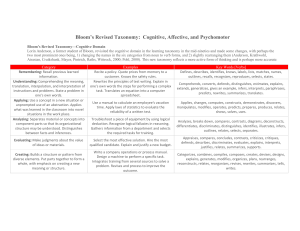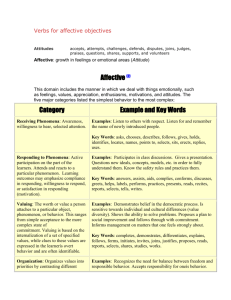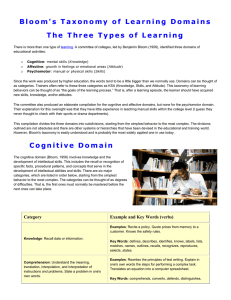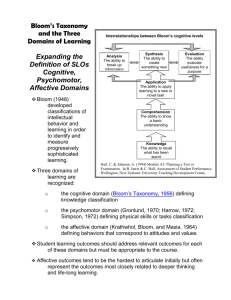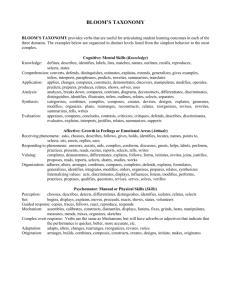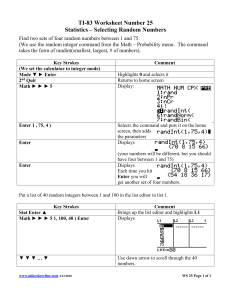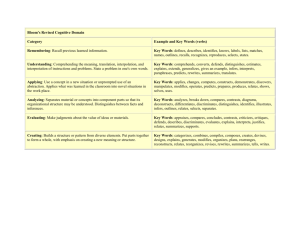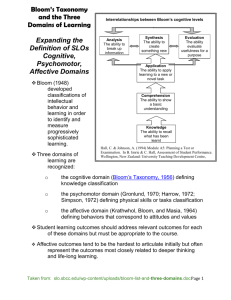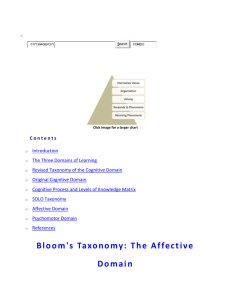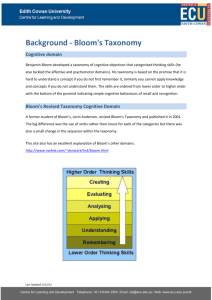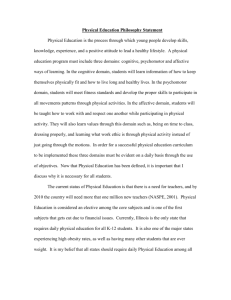Program Assessment Worksheet
advertisement
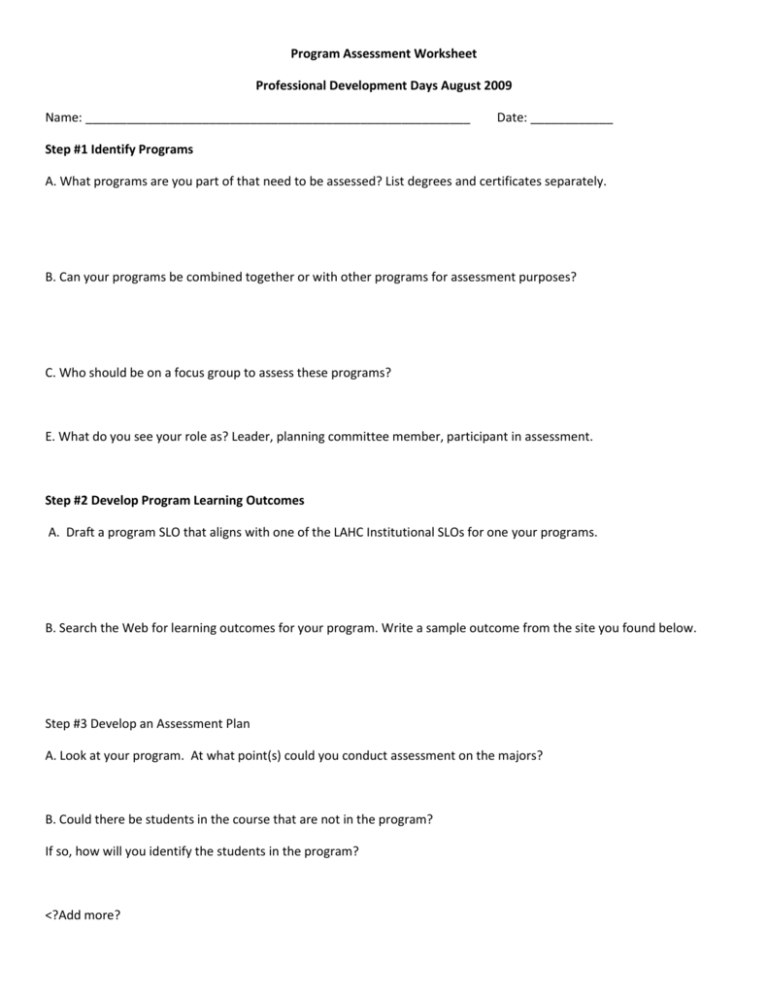
Program Assessment Worksheet Professional Development Days August 2009 Name: ________________________________________________________ Date: ____________ Step #1 Identify Programs A. What programs are you part of that need to be assessed? List degrees and certificates separately. B. Can your programs be combined together or with other programs for assessment purposes? C. Who should be on a focus group to assess these programs? E. What do you see your role as? Leader, planning committee member, participant in assessment. Step #2 Develop Program Learning Outcomes A. Draft a program SLO that aligns with one of the LAHC Institutional SLOs for one your programs. B. Search the Web for learning outcomes for your program. Write a sample outcome from the site you found below. Step #3 Develop an Assessment Plan A. Look at your program. At what point(s) could you conduct assessment on the majors? B. Could there be students in the course that are not in the program? If so, how will you identify the students in the program? <?Add more? Harbor College Institutional Student Learning Outcomes (ISLO) ISLO Examples Reading: Read and comprehend written material critically and effectively at the 1. Communication: appropriate program level. Use language and non-verbal modes of expression appropriate Writing: Write in a clear, coherent, and organized manner, at the appropriate academic level, to explain ideas, to express feelings, and to support conclusions, to the audience and purpose. claims or theses. Speaking: Speak in an understandable and organized fashion to explain ideas, to express feelings, and to support conclusions, claims, or theses. Listening: Listen actively, respectfully, and critically to the substance of others' comments. 2. Cognition: Use critical thinking skills to analyze, synthesize, and evaluate ideas and information. Observing (Visual Literacy): Decode and interpret visual messages, construct meaning from visual images, and produce meaningful visual communication. Problem Solving: Identify and analyze real or potential problems and develop, test, and evaluate possible solutions, using the scientific method where appropriate. Creative Thinking: Formulate ideas and concepts in addition to using those of others. Quantitative Reasoning: Use appropriate program level mathematical concepts and methods to understand, analyze, and explain issues in quantitative terms. Application: Apply knowledge and skills to appropriate contexts and transfer knowledge and skills to new and varied situations. 3. Information Competency: Utilize research skills necessary to achieve educational, professional, and personal objectives. Resource Management: Identify, organize, and allocate resources effectively. Information Literacy: Use print materials, personal communications, observations, and electronic media to locate, retrieve, and evaluate information. Understand the ethical, social and legal issues surrounding the use of information. Technological Competency: Apply technology effectively to locate, interpret, organize, and present information. 4. Social Responsibility: Research Proficiency: Conduct research and present findings effectively. Teamwork: Use skills needed for participation in group efforts to seek effective results. Demonstrate sensitivity to and respect for others and participate actively in group decision making. Respect for Diversity: Demonstrate an understanding of an respect for the feelings, opinions, and values of other people and cultures. 5. Personal Development: Demonstrate self-management, maturity, and growth through practices that promote physical, mental, and emotional wellbeing. Effective Citizenship: Demonstrate responsibility for being an informed, ethical, and active citizen of the local community, California, the nation, and the world. Ethics and Values: Demonstrate an understanding of ethical issues and values required to make sound judgments and decisions. Aesthetic Appreciation: Create or show appreciation for artistic and individual expression. Self-Understanding/Development: Demonstrate increased self-awareness, selfinsight, and personal growth. Perform learned skills competently. The following is from: Clark, D. R. (2009), Bloom's Taxonomy of Learning Domains. Retrieved Aug 14 2009 from http://www.nwlink.com/~donclark/hrd/bloom.html Bloom's Taxonomy of Learning Domains The Three Types of Learning There is more than one type of learning. A committee of colleges, led by Benjamin Bloom (1956), identified three domains of educational activities: Cognitive: mental skills (Knowledge) Affective: growth in feelings or emotional areas (Attitude) Psychomotor: manual or physical skills (Skills) Since the work was produced by higher education, the words tend to be a little bigger than we normally use. Domains can be thought of as categories. Trainers often refer to these three domains as KSA (Knowledge, Skills, and Attitude). This taxonomy of learning behaviors can be thought of as "the goals of the training process." That is, after the training session, the learner should have acquired new skills, knowledge, and/or attitudes. The committee also produced an elaborate compilation for the cognitive and affective domains, but none for the psychomotor domain. Their explanation for this oversight was that they have little experience in teaching manual skills within the college level (I guess they never thought to check with their sports or drama department). This compilation divides the three domains into subdivisions, starting from the simplest behavior to the most complex. The divisions outlined are not absolutes and there are other systems or hierarchies that have been devised in the educational and training world. However, Bloom's taxonomy is easily understood and is probably the most widely applied one in use today. Cognitive Domain The cognitive domain (Bloom, 1956) involves knowledge and the development of intellectual skills. This includes the recall or recognition of specific facts, procedural patterns, and concepts that serve in the development of intellectual abilities and skills. There are six major categories, which are listed in order below, starting from the simplest behavior to the most complex. The categories can be thought of as degrees of difficulties. That is, the first one must be mastered before the next one can take place. Category Example and Key Words Examples: Recite a policy. Quote prices from memory to a customer. Knows the safety rules. Knowledge: Recall data or information. Comprehension: Understand the meaning, translation, interpolation, and interpretation Key Words: defines, describes, identifies, knows, labels, lists, matches, names, outlines, recalls, recognizes, reproduces, selects, states. Examples: Rewrites the principles of test writing. Explain in one's own words the steps for performing a complex task. Translates an of instructions and problems. State a problem in one's own words. equation into a computer spreadsheet. Application: Use a concept in a new situation or unprompted use of an abstraction. Applies what was learned in the classroom into novel situations in the work place. Examples: Use a manual to calculate an employee's vacation time. Apply laws of statistics to evaluate the reliability of a written test. Analysis: Separates material or concepts into component parts so that its organizational structure may be understood. Distinguishes between facts and inferences. Synthesis: Builds a structure or pattern from diverse elements. Put parts together to form a whole, with emphasis on creating a new meaning or structure. Evaluation: Make judgments about the value of ideas or materials. Key Words: comprehends, converts, defends, distinguishes, estimates, explains, extends, generalizes, gives Examples, infers, interprets, paraphrases, predicts, rewrites, summarizes, translates. Key Words: applies, changes, computes, constructs, demonstrates, discovers, manipulates, modifies, operates, predicts, prepares, produces, relates, shows, solves, uses. Examples: Troubleshoot a piece of equipment by using logical deduction. Recognize logical fallacies in reasoning. Gathers information from a department and selects the required tasks for training. Key Words: analyzes, breaks down, compares, contrasts, diagrams, deconstructs, differentiates, discriminates, distinguishes, identifies, illustrates, infers, outlines, relates, selects, separates. Examples: Write a company operations or process manual. Design a machine to perform a specific task. Integrates training from several sources to solve a problem. Revises and process to improve the outcome. Key Words: categorizes, combines, compiles, composes, creates, devises, designs, explains, generates, modifies, organizes, plans, rearranges, reconstructs, relates, reorganizes, revises, rewrites, summarizes, tells, writes. Examples: Select the most effective solution. Hire the most qualified candidate. Explain and justify a new budget. Key Words: appraises, compares, concludes, contrasts, criticizes, critiques, defends, describes, discriminates, evaluates, explains, interprets, justifies, relates, summarizes, supports. Affective Domain The affective domain (Krathwohl, Bloom, Masia, 1973) includes the manner in which we deal with things emotionally, such as feelings, values, appreciation, enthusiasms, motivations, and attitudes. The five major categories are listed from the simplest behavior to the most complex: Category Example and Key Words Receiving Phenomena: Awareness, willingness to hear, selected attention. Examples: Listen to others with respect. Listen for and remember the name of newly introduced people. Key Words: asks, chooses, describes, follows, gives, holds, identifies, locates, names, points to, selects, sits, erects, replies, uses. Responding to Phenomena: Active participation on the part of the learners. Attends and reacts to a particular phenomenon. Learning outcomes may emphasize compliance in responding, willingness to respond, or satisfaction in responding (motivation). Valuing: The worth or value a person attaches to a particular object, phenomenon, or behavior. This ranges from simple acceptance to the more complex state of commitment. Valuing is based on the internalization of a set of specified values, while clues to these values are expressed in the learner's overt behavior and are often identifiable. Organization: Organizes values into priorities by contrasting different values, resolving conflicts between them, and creating an unique value system. The emphasis is on comparing, relating, and synthesizing values. Internalizing values (characterization): Has a value system that controls their behavior. The behavior is pervasive, consistent, predictable, and most importantly, characteristic of the learner. Instructional objectives are concerned with the student's Examples: Participates in class discussions. Gives a presentation. Questions new ideals, concepts, models, etc. in order to fully understand them. Know the safety rules and practices them. Key Words: answers, assists, aids, complies, conforms, discusses, greets, helps, labels, performs, practices, presents, reads, recites, reports, selects, tells, writes. Examples: Demonstrates belief in the democratic process. Is sensitive towards individual and cultural differences (value diversity). Shows the ability to solve problems. Proposes a plan to social improvement and follows through with commitment. Informs management on matters that one feels strongly about. Key Words: completes, demonstrates, differentiates, explains, follows, forms, initiates, invites, joins, justifies, proposes, reads, reports, selects, shares, studies, works. Examples: Recognizes the need for balance between freedom and responsible behavior. Accepts responsibility for one's behavior. Explains the role of systematic planning in solving problems. Accepts professional ethical standards. Creates a life plan in harmony with abilities, interests, and beliefs. Prioritizes time effectively to meet the needs of the organization, family, and self. Key Words: adheres, alters, arranges, combines, compares, completes, defends, explains, formulates, generalizes, identifies, integrates, modifies, orders, organizes, prepares, relates, synthesizes. Examples: Shows self-reliance when working independently. Cooperates in group activities (displays teamwork). Uses an objective approach in problem solving. Displays a professional commitment to ethical practice on a daily basis. Revises judgments and changes behavior in light of new evidence. Values people for what they are, not how they look. Key Words: acts, discriminates, displays, influences, listens, modifies, performs, practices, proposes, qualifies, questions, general patterns of adjustment (personal, social, emotional). revises, serves, solves, verifies. Psychomotor Domain The psychomotor domain (Simpson, 1972) includes physical movement, coordination, and use of the motorskill areas. Development of these skills requires practice and is measured in terms of speed, precision, distance, procedures, or techniques in execution. The seven major categories are listed from the simplest behavior to the most complex: Category Perception: The ability to use sensory cues to guide motor activity. This ranges from sensory stimulation, through cue selection, to translation. Example and Key Words Examples: Detects non-verbal communication cues. Estimate where a ball will land after it is thrown and then moving to the correct location to catch the ball. Adjusts heat of stove to correct temperature by smell and taste of food. Adjusts the height of the forks on a forklift by comparing where the forks are in relation to the pallet. Key Words: chooses, describes, detects, differentiates, distinguishes, identifies, isolates, relates, selects. Set: Readiness to act. It includes mental, physical, and emotional sets. These three sets are dispositions that predetermine a person's response to different situations (sometimes called mindsets). Guided Response: The early stages in learning a complex skill that includes imitation and trial and error. Adequacy of performance is achieved by practicing. Examples: Knows and acts upon a sequence of steps in a manufacturing process. Recognize one's abilities and limitations. Shows desire to learn a new process (motivation). NOTE: This subdivision of Psychomotor is closely related with the "Responding to phenomena" subdivision of the Affective domain. Key Words: begins, displays, explains, moves, proceeds, reacts, shows, states, volunteers. Examples: Performs a mathematical equation as demonstrated. Follows instructions to build a model. Responds hand-signals of instructor while learning to operate a forklift. Key Words: copies, traces, follows, react, reproduce, responds Mechanism: This is the intermediate stage in learning a complex skill. Learned responses have become habitual and the movements can be performed with some confidence and proficiency. Examples: Use a personal computer. Repair a leaking faucet. Drive a car. Complex Overt Response: The skillful performance of motor acts that involve complex movement patterns. Proficiency is indicated by a quick, accurate, and highly Examples: Maneuvers a car into a tight parallel parking spot. Operates a computer quickly and accurately. Displays competence while playing the piano. Key Words: assembles, calibrates, constructs, dismantles, displays, fastens, fixes, grinds, heats, manipulates, measures, mends, mixes, organizes, sketches. Key Words: assembles, builds, calibrates, constructs, dismantles, coordinated performance, requiring a minimum of energy. This category includes performing without hesitation, and automatic performance. For example, players are often utter sounds of satisfaction or expletives as soon as they hit a tennis ball or throw a football, because they can tell by the feel of the act what the result will produce. Adaptation: Skills are well developed and the individual can modify movement patterns to fit special requirements. displays, fastens, fixes, grinds, heats, manipulates, measures, mends, mixes, organizes, sketches. NOTE: The Key Words are the same as Mechanism, but will have adverbs or adjectives that indicate that the performance is quicker, better, more accurate, etc. Examples: Responds effectively to unexpected experiences. Modifies instruction to meet the needs of the learners. Perform a task with a machine that it was not originally intended to do (machine is not damaged and there is no danger in performing the new task). Key Words: adapts, alters, changes, rearranges, reorganizes, revises, varies. Origination: Creating new movement patterns to fit a particular situation or specific problem. Learning outcomes emphasize creativity based upon highly developed skills. Examples: Constructs a new theory. Develops a new and comprehensive training programming. Creates a new gymnastic routine. Key Words: arranges, builds, combines, composes, constructs, creates, designs, initiate, makes, originates. Other Psychomotor Domains As mentioned earlier, the committee did not produce a compilation for the psychomotor domain model, but others have. The one discussed above is by Simpson (1972). There are two other popular versions: Dave's (1975): Imitation: Observing and patterning behavior after someone else. Performance may be of low quality. Example: Copying a work of art. Manipulation: Being able to perform certain actions by following instructions and practicing. Example: Creating work on one's own, after taking lessons, or reading about it. Precision: Refining, becoming more exact. Few errors are apparent. Example: Working and reworking something, so it will be "just right." Articulation: Coordinating a series of actions, achieving harmony and internal consistency. Example: Producing a video that involves music, drama, color, sound, etc. Naturalization: Having high level performance become natural, without needing to think much about it. Examples: Michael Jordan playing basketball, Nancy Lopez hitting a golf ball, etc. Harrow's (1972): Reflex movements - Reactions that are not learned. Fundamental movements - Basic movements such as walking, or grasping. Perception - Response to stimuli such as visual, auditory, kinesthetic, or tactile discrimination. Physical abilities - Stamina that must be developed for further development such as strength and agility. Skilled movements - Advanced learned movements as one would find in sports or acting. No discursive communication - Effective body language, such as gestures and facial expressions. The following is from: “Assessment at the Program Level” by Trudy H. Bers at http://virtual2.yosemite.cc.ca.us/mjcinstruction/CAI/Resources/Prog%20Level%20Assessment%20by%20Bers. doc Assessment Approaches Many approaches are available for assessing student outcomes at the program-level, though some are more feasible than others. Capstone course. Some programs have a capstone course, a course required of students at the end of the program that integrates material covered earlier and to demonstrate their learning through various combinations of tests, papers, portfolios, simulations, team assignments, presentations and other methods for demonstrating learning. The instructor of record, several faculty members in the program, advisory committee or other industry practitioners, or a combination of these can evaluate student learning in capstone courses. Though technically assessment is occurring at the course level, the course is designed to approximate the totality of key learning expected of students completing the program. Therefore course learning outcomes are interpretable as program-level learning outcomes as well. Vendor or industry certification examination. Some fields, especially those in technologies, are experiencing a growth of certification examinations administered by vendors or professional/industry organizations. Certification is external validation that the student has learned knowledge and skills identified by the vendor or organization as essential for a particular job or credential. The examining body may not care where test takers obtained their knowledge, and may not even care whether this was achieved through coursework or self-study. Community colleges may develop programs intended to prepare students for these examinations, however, and use results as indicators of program-level learning. Standardized testing. In some fields standardized tests may be available. When administered to students near the end of their programs, test results provide indications to the student and the institution about the program-level learning that has occurred. In reality, standardized tests are often difficult to use in community colleges. They are not available in all areas and may be expensive with respect both to actual dollar outlays and the resources required to administer them under rigorous testing protocols. Standardized tests are often controversial, especially when faculty believe the standardized test doesn’t align with program objectives. Moreover, unless test results directly impact graduation or grade point averages, students have little incentive to take the tests seriously, even if taking the test itself, rather than the score attained, is a graduation requirement. Satisfaction surveys. Student and alumni satisfaction surveys that include self-reported estimates of learning provide indirect evidence of student learning outcomes. Though most powerful when results are triangulated with more direct assessments of learning, satisfaction surveys can be especially helpful when respondents are currently working in the field and are providing feedback about whether what they believe they learned in the program has adequately prepared them for the workplace. Satisfaction surveys are available through a number of commercial providers, and may be institutionally developed as well. Institutional or departmental testing. This approach requires faculty to agree on one or more standardized or institutionally developed tests that touch on all or most essential elements of a program. The test would be administered to all students at the completion of the program, however completion may be operationally defined; e.g., end of a culminating course, prior to receiving a degree or certificate, or prerequisite for enrollment in a capstone course or practicum/seminar experience. Because students would take the test regardless of instructor and at or near the end of the curriculum, results may be interpreted as indicating acquisition of knowledge, skills and attitudes at the program-level. Portfolio assessment. Portfolios are collections of students’ work that demonstrate learning and development. Work is carefully assessed by faculty or other content-area experts and typically evaluated holistically. Portfolios can consist of hard and/or electronic copies of students’ work, and include artifacts such as student-written papers, projects, videotapes of presentations, resumes, sample letters of application for jobs, and other materials that give evidence of achievements. For program-level assessment, portfolios need to contain documentation of learning and development across the spectrum of program objectives. Performance manuals. A performance manual lists and briefly describes behaviors a student should be able to execute with competency at the conclusion of a program. Faculty evaluate students’ abilities to perform these behaviors, regardless of whether they are observed in class, at clinical settings, through service-learning or other service or support activities, or elsewhere (Boland and Laidig, 2001). Narratives. Benner (1999) suggests a novel approach to assessment: having students recount their experiences through stories, with faculty then assessing learning by listening to and questioning students to determine whether the students demonstrate understanding of the context and content of situations being described. This approach requires students and faculty to engage in dialog; while it may provide rich insights into how and what each student has learned, translating information into summary form for program improvement may be challenging. Culminating project. A culminating project may be linked with a capstone course or internship experience or stand alone as a requirement for program completion. The project needs to be broadly defined and reflect student learning and ability to integrate information from across the curriculum. Projects may be graded by faculty, by outside experts or by a combination of internal and external evaluators. The project differs from a portfolio in that a portfolio is a collection of student work gathered throughout the student’s time at the institution, whereas the project is a more focused work that addresses a particular situation or simulation. For example, students in fashion merchandising might be required to put together a marketing campaign, including sample ads, budgets, media schedules, and displays to promote a new line of sportswear targeted to young teens, and then to present the campaign to an audience of faculty, peers and industry representatives. In the performing arts, the concept “juried performance” is often used to identify student works evaluated by outside experts. Transfer to and success in another institution, usually a four-year college or university. Though community college transfer programs usually award an associate degree when a student completes the program, the primary purpose for these programs is to provide students with the first two years of undergraduate work and to give them the necessary knowledge and skills so they can succeed in upper division coursework. We assume, usually without verifying this, that when a student transfers the receiving institution has scrutinized the student’s record at the community college and positively evaluated the learning implied on that record. We also assume, again without verification, that most if not all the student’s credits from the community college will transfer as well. Thus an indirect indicator of student learning is acceptance at and transfer to a four-year college or university. The National Student Clearinghouse EnrollmentSearch program enables participating institutions to learn if and where students transfer. The Clearinghouse claims to have data for some 80 percent of all students enrolled in postsecondary education in the United States. Names and birth dates are used to match student records. LA HARBOR COLLEGE Student Learning Outcomes (SLOs) Assessment Report Program Assessment Program Name: ___________________________________________________________________________ Division (if applicable): ___________________________ Program Contact Person: ________________________________________ Phone: _______________________ Reviewed by: Date: Attach additional pages as necessary. Institutional Program Student Learning SLO Outcomes Number , Academic Dean Means of Assessment and Criteria for Success Summary of Data Collected Use of Results Timeline for Program Modification
